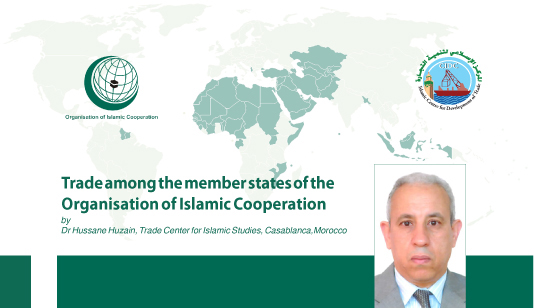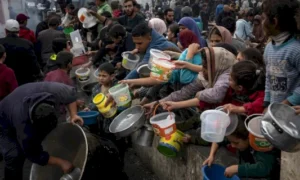Trade among the member states of the Organisation of Islamic Cooperation by Dr Hussane Huzain, Trade Center for Islamic Studies, Casablanca,Morocco
World Trade
Financial tensions in the Euro Zone, natural disasters, in particular floods, the earthquake which struck Japan in 2011, tighter economic policies, the decline in domestic demand and increased risk aversion of investors, and the monetary fluctuations contributed to the slowdown of the global economy in 2011. The earthquake in Japan and floods in Thailand have contributed to the disruption of global supply chains especially in China. Indeed, the world production growth was only 2.4% and that of trade in goods and services 5% in 2011.
This conjuncture did affect the prices of raw materials, which recorded an increase in commodities by 26% between 2010 and 2011 including the price of energy products (+32%), agricultural materials (+23%), beverages (+20%), food products (+17) and metals (+14%). In addition, the Arab Spring had a negative impact on the growth of trade in goods and services in the region of concerned countries. Indeed, the interruption of supplies of Libyan oil reduced African exports by 8% in 2011. Despite this difficult situation, world commodity exports grew by 20% reaching US$ 17.8 trillion in 2011 due to rising commodity prices. Commercial services exports totaled US$ 4.1 trillion, i.e. 23% of world exports of goods and services in 2011.
The major exporters of goods and services are China, the U.S, Germany, Japan and the Netherlands, which totaled approximately 35.6% of world exports. World imports surpassed US$ 18 trillion in 2011, representing a 19% increase compared to 2010.
The main importers are the United States, China, Germany, Japan and France who have accumulated 38% of world imports of goods and services. Commercial services imports totaled US$ 3.9 trillion, i.e. 21.7% of world imports of goods and services in 2011.
TRENDS IN FOREIGN TRADING OF THE OIC MEMBER STATES:
Foreign Trade:
Despite the global economic crisis, trading by the OIC Member States continued to grow; this is explained by higher energy prices and of other commodities by about 26% between 2010 and 2011 and the increase in demand in the OIC countries. Member States’ Trade increased from US$ 3.2 trillion in 2010 to US$ 3.9 trillion in 2011, an increase by 22%. Trade of the OIC Member States accounted for 10.8% of world trade in 2011.
The main actors in world trade amongst the OIC Member States in 2011 were: Saudi Arabia (US$ 458 billion), the UAE (US$ 455 billion), Malaysia (US$ 415 billion), Indonesia (US$ 381 billion), Turkey (US$ 376 billion), Iran (US$ 222 billion), Nigeria (US$ 166 billion), Qatar (US$ 131 billion), Kuwait (US$ 110 billion) and Algeria (US$ 105 billion).
These ten countries accounted for 72.7% of world trade of the OIC Member States in 2011. The main products concerned by the world trade of Member States in 2011 were: miscellaneous manufactured goods (29%), mineral fuels (23%), machinery and transport equipment (18%), food products (16%), chemicals (8%) and non-edible materials (7%). Trade in services (debits + credits) of the OIC Member States accounted for 7.4% of world trade in services in 2011 equivalent to US$ 595 billion, i.e. a decrease by 9.8% compared to 2010 due to lower transport services and rising energy prices during this period.
Trade in services of Member States accounted for 16% of the global trade of the OIC countries in 2011 against 18.8% in 2010.
The structure of trade in services of the OIC Member States is as follows: travel (31%), government services (22%), transport (21%), communications (5%), licenses and royalties (4%), construction (3%), insurance (2%), recreational and cultural services (2%) and other services (10%).
Exports:
World exports increased by 26.3% rising from US$ 1.7 trillion in 2010 to US$ 2.12 trillion 2011.
This trend has been reinforced by the important growth of exports of the following countries: Saudi Arabia (+US$ 103.3 billion; 45.4% growth between 2010 and 2011), the United Arab Emirates (+US$ 84.8 billion; 54.5%), Indonesia (+US$ 45.7 billion; 29%), Qatar (+US$ 41.5 billion; 63.8%), Nigeria (+US$ 31.3 billion; 41%), Iran (+US$ 26.5 billion; 25.9%), Kuwait (+US$ 26.1 billion; 43.4%), Turkey (+US$ 21 billion; 18.4%), Iraq (+US$ 20.6 billion; 43.7%), Kazakhstan (+US$ 14.6 billion; 29.3%).
The main products exported by Member States are: miscellaneous manufactured goods (32%), mineral fuels (29%), food products (17%), non-edible raw materials (10%), machinery and equipment transport (7%) and chemicals (5%).
Imports:
World imports of the OIC Member States in 2011 totaled US$ 1.8 trillion against US$ 1.5 trillion in 2010, i.e. an increase by 17% due to the increase in global imports of the following countries: Turkey (+US$ 55.3 billion, i.e. 29.8% growth between 2010 and 2011), the United Arab Emirates (+US$ 47.9 billion; 28.8%), Indonesia (+US$ 41.8 billion; 30.8%), Saudi Arabia (+US$ 24.1 billion; 23.4%), Iran (+US$ 23.3 billion; 33.1%), Nigeria (+US$ 10.5 billion; 22%), Iraq (+US$ 9.1 billion; 33%), Bangladesh (+US$ 7.5 billion; 26%), Morocco (+US$ 6.2 billion; 16.7%) and Algeria (+US$ 5.8 billion;13.9%).The main products imported by the Member States are: machinery and transport equipment (29%), miscellaneous manufactured goods (26%), mineral fuels (17%), food products (15%), chemicals (10%) and non-edible raw materials (3%).
TRENDS OF INTRA-OIC TRADE:
Intra-OIC trade:
Trade volume between the OIC Member States (intra-OIC exports + intra-OIC imports) in 2011 reached a value of US$ 681.6 billion against US$ 539 billion in 2010, an increase by 26.5% due to the reasons mentioned above. In addition, in the case of economic crisis, Member States tend to increase their intra-Community trade thanks to geographic proximity, the existence of bilateral and regional agreements; the similarity of patterns of consumption, complementarity and the regional promotional efforts of the Consultative Group on Enhancing Intra-OIC trade, the number of projects has exceeded 300 in August 2012.
The net intra-OIC trade ((intra-OIC exports + intra-OIC imports)/2) in 2011 reached a value of US$ 340.8 billion against US$ 269.5 billion in 2010, an increase by 26.5%.Despite the effects of the global economic crisis, the share of intra-OIC trade in the total trade of Member States increased from 17.03% in 2010 to 17.80% in 2011, i.e. an increase by 4.5%.
Countries with greater complementarity in the OIC zone in 2011 with a complementarity trade index higher than 0.30 were: Malaysia (0.54), Turkey (0.46), Egypt (0.44), Indonesia (0.44), United Arab Emirates (0.43), Tunisia (0.43), Syria (0.37), Lebanon (0.37), Albania (0.34), Jordan (0.34), Oman (0.31), Djibouti (0.31), Afghanistan, Bahrain and Morocco with 0.30 each. The major actors of intra-OIC trade in 2011 were: The United Arab Emirates (US$ 91 billion), Turkey (US$ 69 billion), Saudi Arabia (US$ 64 billion), Iran (US$ 57 billion), Indonesia (US$ 50 billion), Malaysia (US$ 48 billion), Pakistan (US$ 30 billion), Iraq (US$ 29 billion), Syria and Egypt US$ 24 billion each. These ten countries represented 71.3% of intra-OIC trade in 2011. The main products covered by the intra-OIC trade in 2011 are: and miscellaneous manufactured goods (31%), mineral fuels (25%), food products (17%), machinery and transport equipment (13%), chemicals (11%) and non-edible materials (4%).
It should be noted that the 29 following Member States exceeded in 2011,the threshold of 20% of the level of intra-OIC trade advocated by the Ten Year Programme of Action (TYPOA) by 2015, these are: Somalia, Djibouti, Syria, Lebanon, Afghanistan, Jordan, Pakistan, Tajikistan, Kyrgyzstan, Iraq, Comoros, Burkina Faso, Senegal, Côte d’Ivoire, Turkmenistan, Niger, Yemen, Uzbekistan, Egypt, Libya, Oman, Mali, Togo, Iran, Uganda, Bahrain, Sudan, Guinea Bissau, and Turkey. Thus, these countries and the rest of the member states have to be more involved in the field of capacity building, participation in trade fairs, international exhibitions and business forums, especially in those organized by ICDT and alleviation of intra-OIC foreign trade and investment procedures. The diversification of exportable supply is needed to develop intra-OIC foreign trade and investment.
Some member states have developed diversification policies of their exports in recent years, these are: Malaysia (260 exported products with diversification index of 0.47 according to UNCTAD, 2012), Turkey (253; 0.51), Tunisia (226; 0.54), Egypt (238; 0.55), Indonesia (241; 0.56), U.A. E (260; 0.56), Jordan (243; 0.59), Djibouti (216; 0.61), Lebanon (236; 0.61), Syria (237; 0.61). The more the diversification index is low, the more the country is provided with a highly diversified exportable supply. Other countries have to develop diversification strategies of their exports in order to find more trading partners in the following countries: Comoros, Guinea Bissau, the Gambia, Chad, Tajikistan, Mauritania, Guinea, Niger, Algeria and Somalia whose products vary between 7 and 100 at export level. With respect to OIC, the average is 176 products with diversification index of 0.72 in 2011.
The intra-OIC exports
The intra-OIC exports totaled US$ 325.4 billion in 2011, i.e. 15.33% of total exports of Member States against US$ 257.7 billion in 2010, i.e. an increase by 26.3%. This rise is due to increased intra-OIC exports of the following countries: the United Arab Emirates (+US$ 24.9 billion, i.e. a 70.2% increase in intra-OIC exports between 2010 and 2011), Saudi Arabia (+US$ 9.4 billion; 26.2%), Iran (+US$ 5.5 billion; 40.9%), Turkey (+US$ 4.8 billion; 14.7%) , Indonesia (+US$ 4.5 billion; 24.2%), Iraq (US$ +2.8 billion; 117.9%), Kuwait (+US$ 2.8 billion; 32.5 %), Oman (+US$ 2.2 billion; 35.5%), Nigeria (+US$ 2.2 billion, 42.9%) and Qatar (+US$ 1.8 billion; 78.4%). The Major exporters in the OIC zone are: United Arab Emirates (US$ 60.4 billion), Saudi Arabia (US$ 45.3 billion), Turkey (US$ 37.3 billion), Malaysia (US$ 24.9 billion), Indonesia (US$ 22.9 billion), Iran (US$ 19 billion), Egypt (US$ 12 billion), Kuwait (US$ 11.2 billion), Syria (US$ 10.5 billion), Pakistan (US$ 9 billion). The intra-OIC exports of those ten countries accounted for 77.6% of total intra-OIC exports in 2011.
The main products exported between the Member States of the OIC are: manufactured goods (28% of intra-OIC exports), mineral fuels (25%), food products (18%), machinery and transport equipment (14%), chemicals (11%) and inedible raw materials (4%).
The intra-OIC imports:
The intra-OIC imports represent 20.26% of global imports of the OIC countries with a value of US$ 356.2 billion in 2011 against US$ 281.3 billion in 2010, an increase by 26.6%. This increase is due to the growth of intra-OIC imports of the OIC countries: Iran (+US$ 17.8 billion; 89.4%) growth of intra-OIC imports ), Iraq (+US$ 9.6 billion; 68.3%), Indonesia (+US$ 6.5 billion; 31.9%), the United Arab Emirates(+US$ 5.7 billion; 22.5%), Malaysia (+US$ 5.3 billion; 30.7%), Pakistan (+US$ 4.8 billion; 27.6%), Kuwait (+US$ 4 billion; 77.4%), Saudi Arabia (+US$ 3.9 billion; 22.6%), Turkey (+US$ 3.5 billion; 12.4%), Bangladesh (+US$ 2.7 billion; 47.7%) and Qatar (+US$ 2.6 billion; 47.3%).
The main importing countries of the OIC Zone in 2011 are: Iran (US$ 37.7 billion), Turkey (US$ 31.4 billion), the United Arab Emirates (US$ 30.9 billion), Indonesia (US$ 26.8 billion), Iraq (US$ 23.7 billion), Malaysia (US$ 22.8 billion), Pakistan (US$ 21.3 billion), Saudi Arabia (US$ 18.5 billion), Syria (US$ 13.3 billion) and Egypt (US$ 12.4 billion), which totaled 67.1% of intra-OIC imports. The main products imported from Member States of the OIC are: miscellaneous manufactured goods with 33% of intra-OIC imports followed by mineral fuels (25%), food products (15%), machinery and transport equipment (12%), chemicals (11%) and non-edible materials (4%).
OBSTACLES TO INTRA-OIC TRADE DEVELOPMENT:
Despite considerable efforts at the OIC level and by Member States to promote intra-OIC trade and eliminate bottlenecks, many obstacles still exist, notably:
• Problems of market access: tariff, para-tariff and often non-tariff obstacles; • Barriers in logistics infrastructure, transport, weak or unsuitable support services to international trade;
• Existence of a non-diversified exportable supply and not adapted to the norms and standards of the markets;
• Lack of information on markets and business opportunities, despite efforts by ICDT and the other OIC Concerned Institutions on the subject;
• Limited meeting opportunities and promotion of domestic production in other OIC markets;
• Complexity of administrative procedures related to foreign trade at the level of customs, banks, ports, etc.;
• Lack of managers and technicians specialised in international trade;
• Inadequate and insufficient financing instruments especially, for the benefit of SME-SMI.
Obstacles to exports:
According to a survey conducted by ICDT at the level of exporters, the main obstacles to the development of intra-OIC exports are: the cost of developing new markets, foreign exchange risks, the cost or supply of labour, the regulation of foreign government, the collection of information on Member States’ markets, getting licenses or bonds and local partners.
Obstacles to imports:
According to a survey conducted by ICDT at the level of exporters, the main obstacles reported are: the risk of not having authorizations from the Foreign Exchange service and obtaining bank guarantees to carry out imports followed by political and commercial risks, quality standards, sanitary and phytosanitary measures, customs valuation and customs procedures, obtaining import licenses and safeguards and rules of origin.
Trade between the states of the Gulf Cooperation Council (GCC)
Trade among the GCC Member States reached US$ 28.6 billion in 2010 against US$ 38.7 billion in 2011; an increase by 35.3%. This is due to the increase of intra-GCC exports of the UAE (+US$ 3.7 billion; 36.9%), Saudi Arabia (US$ 3.6 billion; +35, 1%), Oman (+1.4 billion U.S. dollars; + 31.8%), Bahrain (+US$ 837.9 million; 42.1%), Kuwait (+US$ 351 million; +30.4%) and Qatar (+US$ 251.6 million; +29%) during this period. Moreover, it was noted that the intra-GCC trade accounted for 30% of intra-regional trade of the OIC and 31% of intra-OIC total trade in 2011.
Intra-Middle East Trade
Trade among the Middle East’s countries reached US$ 29.5 billion in 2010 against US$ 33.3 billion in 2011, an increase by 13% due to increased level of exports among intra-Middle East countries such as Turkey (+US$ 2.5 billion; +21%), Iraq (+1.6 billion U.S. dollars; 73.9%) and Egypt (+US$ 318 million; +8.2 %). Intra-Middle East accounts for 25% of intra-OIC trade and intra-regional OIC in 2011. The main suppliers are: Turkey, Syria, and Egypt, which reached 78.4% of exports between the countries of this region, while the main clients are: Iraq, Syria and Turkey, which absorbed 74% of intra-Middle East exports in 2011.
1. Quantitative restrictions on imports: mean the import quotas, import bans, voluntary export restrictions and import licensing systems. At the WTO, the Agreement on Import Licensing Procedures stipulates that they should be simple and transparent; governments must publish sufficient information for importers to know how they could easily obtain these licenses when all relevant conditions are met. The OIC countries must therefore work to reduce the burden of license application process on the importer to ensure that the procedures adopted are of no effect to restrict trade.
2. Rules and customs and administrative procedures: the results of surveys made with the economic operators of OIC countries show that they are facing problems, especially those relating to the inefficiency and complexity of customs and administrative procedures.
3. Technical Barriers to Trade: obviously these barriers significantly impede exports of OIC countries especially to developed countries; technical regulations of which; standards and procedures for conformity assessment can serve as protection instruments. Weakness or lack of adequate infrastructure to check and certify the technical standards conformity assessment constitute a major handicap for (LDCs) when it comes to prove that their products meet international standards.
4. Sanitary and phytosanitary measures (SPS) are particularly important for the OIC countries as a result of the share of their agricultural exports. The emergences of biotechnology and international trade in this area have led to the use of restrictive measures that are costly and burdensome for the OIC countries and developing countries in general.
5. Other obstacles: Recent studies reveal concerns about the rules and regulations relating to the environment and non-compliance with labour standards, including provisions relating to child labour applied by developed countries.























Pingback: Intra-Trade Investments In Muslim World Emphasized - The Halal Times